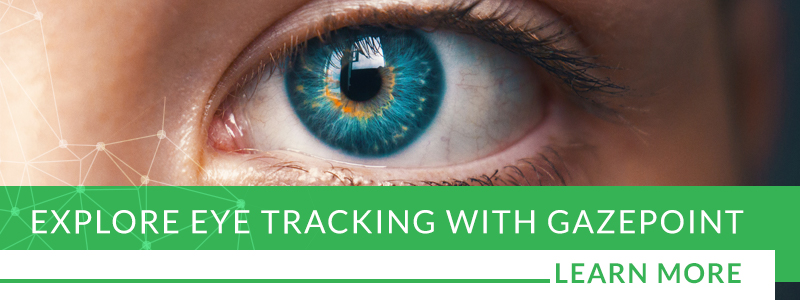
The Psychology of Eye Movements
You may have worked in the field of eye-tracking technology for a long time. In fact, you probably know more than most people about the way the pupil, cornea, and retina all work together to transform images into signals that are sent to the brain. With all of the information you have gleaned over the years, have you ever stopped to ask yourself why the eyes move? Most people don’t, as it is an accepted fact that eyes simply move.
We’ll take a brief look at the reason for why the human eyes move, and then delve a bit into the psychology behind this movement. Gazepoint offers the affordable solutions you need for eye tracking, neuromarketing, and biometric research. From teaching tools and medical research to UX designers and corporate developers, our eye-tracking technology is well-suited for a variety of applications across a number of industries. Find the visual tracking bundles you need for your field and place your order today.
Why Eyes Move
When you look straight ahead, your eyes are able to cover a visual field of about 180 degrees horizontally and 90 degrees vertically. With such a broad visual field, it’s important for the eyes to focus on just a small portion. If everything in our visual field were in focus, our brain would be overloaded with information. While your eyes are able to take in everything within their visual field, they focus on just 2 degrees of the field, which is called foveal vision. The fovea refers to the center of the retina where the cells that are responsible for high visual acuity are clustered.
Eye Direction and Behavior
When you meet someone for the first time, you probably look at their eyes as one of your first subconscious attempts to read them. Based on what you see in another person’s eyes, you might be able to make some accurate predictions about their behavior and hidden emotions.
Nonverbal Cues
Eye-Blocking
Sometimes, when people literally do not like what they see, they will cover or shield their eyes. This can be a reaction either to something they are seeing or hearing, and it’s an indicator that they are very uncomfortable.
Pupillometry
Pupillometry is the measurement of pupil size and reactivity. Not only is it part of a clinical neurological exam for people who may have neurological injuries, but it is also used in psychology. When people see something stimulating or are aroused, their pupils will stay dilated. Conversely, when people see something negative, their pupils will constrict in an attempt to block out the image.
Persistent Eye Contact
When engaged in conversation, eye contact with another person is expected to be regular but not overly consistent. In fact, the level and consistency of eye contact are frequently evaluated subconsciously by most people to evaluate whether another person is being honest and direct with them.
Evasive Eye Contact
Conversely, evasive eye contact can communicate shame or a sense of dishonesty. If someone’s eyes shift a lot or if they are unable to maintain eye contact during a conversation, then this behavior could be perceived as negative nonverbal communication. Interestingly, however, in a question-and-answer situation, when someone looks away to consider their response rather than maintaining persistent eye contact, they are more likely to provide a correct answer.
Blinking
While it’s natural to blink to provide moisture for your eyes, there are other times that blinking can provide insight into a person’s behavior and emotions. Subconsciously, our emotions and feelings toward another person can cause us to alter our blink rate when engaged in conversation with them. For this reason, blinking more than the average of six to 10 times per minute is often seen as a sign of flirting. Rapid blinking can be a good indicator that someone is attracted to the person with whom they are talking.
Eye Direction
Generally speaking, the direction someone looks in doesn’t have significant meaning. It becomes important, however, when they are considering an answer or response. Looking to the left while thinking can indicate that a person is either reminiscing or trying to remember something. Since looking to the right while thinking typically indicates creative thoughts, this eye direction can be interpreted as a potential sign of deceitfulness. Be careful about jumping to conclusions, however, since someone who is left-handed will likely reverse these eye-direction indicators.
Visual Tracking Options
No matter what field or industry in which you work, there are a variety of eye-tracking solutions to suit your needs. From healthcare and education to usability and market research, there are a number of applications for eye-tracking technology. Find the eye-tracking hardware and software you need at Gazepoint. Contact us for assistance with selecting the right eye tracker for your needs. Place your order today, and get the visual tracking insight you need to propel your business toward success.



